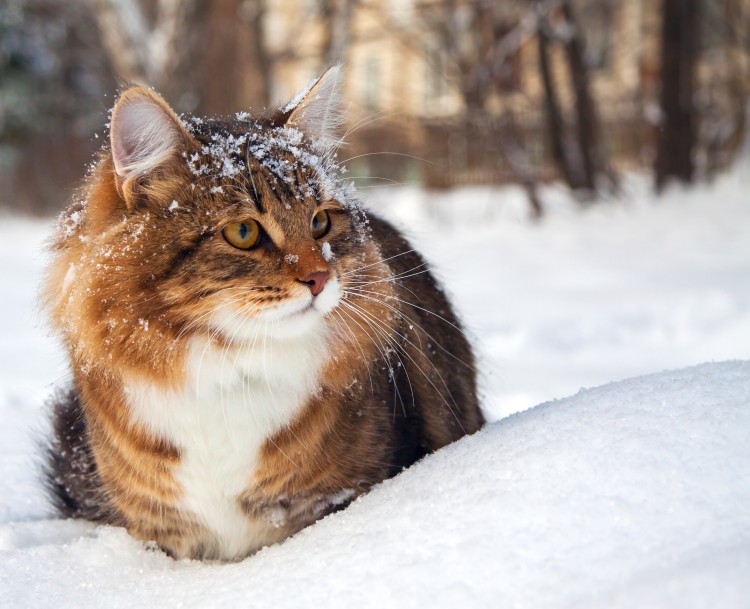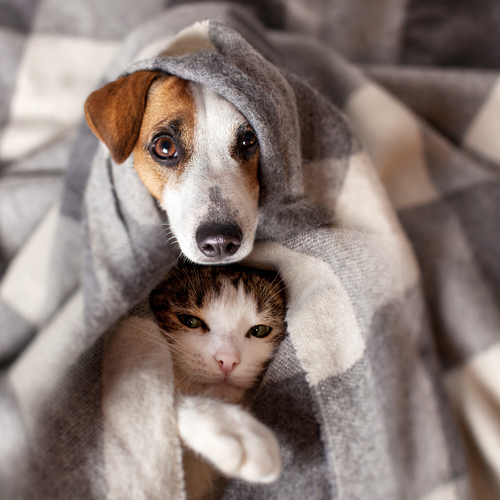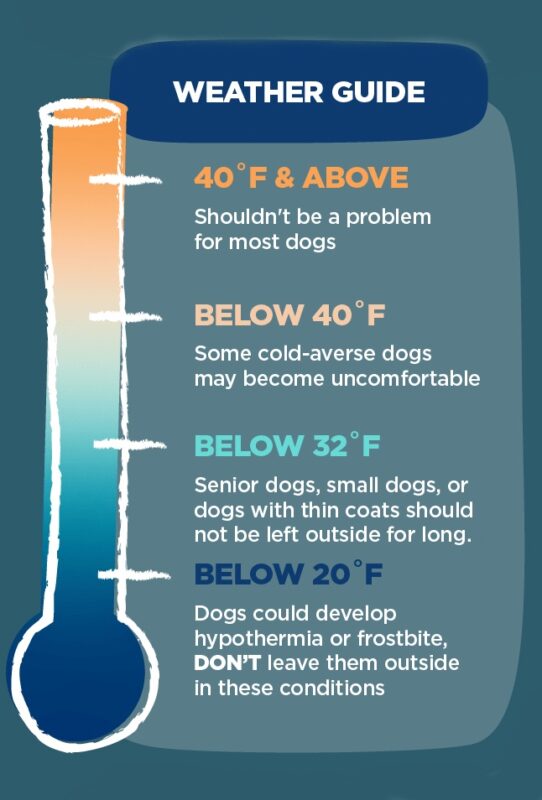10 Tips to Keep Your Pets Warm and Safe This Winter
Posted: 12/23/2022 | BY: Katrina Shedden | Categories: Cat , Dog , Pet care , Top Tips
Winter is upon us! And while many folks are excited to get out their skis and head for the mountains… it’s important to remember that winter can be too cold for some of our pets to be outdoors for more than a short time. Keep reading for 10 tips to keep your pets warm and safe this winter while still enjoying outdoor winter activities.

As we shiver into the coldest days of the year, it’s important to remember some breeds of pets are better at coping with the winter chill than others. So here are 10 tips on how to keep your pets warm and safe this winter.
1. Limit outdoor time
Some breeds are built for the winter! Others, not so much. Even when it’s cold and wet, and in some states, very, VERY cold, our pets still want to go outside. So it’s important to make sure they can cope with the winter conditions where you live.
Bigger, furrier dog breeds, and those bred for the cold, can cope quite well in wintry conditions. But many short-haired and smaller size dogs can’t handle the extreme weather as adeptly. So it’s important to understand your pets’ breed and the temperatures they can tolerate without jeopardizing their safety. Puppies and kittens are especially less tolerant of the cold because they have less fat and muscle to protect and insulate them.
With any pet, when temperatures drop to freezing outside, it’s safer to keep them indoors and limit time outside to short bathroom or exercise breaks, if necessary. Puppies, small or short-haired dogs, and senior pets of any breed should only go out for very short periods of time. Some pets lose heat quickly and are at greater risk of hypothermia and frostbite. So, if it’s too cold for you, it’s most likely too cold for them too.
Consider keeping your cats indoors when it’s too cold outside, even for you. Make sure they have access to a litter tray indoors, and if they are still desperate to go out, supervise short outdoor breaks, then get them back inside. Outdoor pets should have an insulated shelter or a warm garage or shed to weather the cold or snow safely.
2. Know the signs of distress
If your pet gets too cold and their body temperature falls, they might shiver, appear disorientated, have a slow heartbeat, or shallow breaths. For frostbite and hypothermia, symptoms can include skin discoloration or ulcers, blisters, swelling, or pain where certain parts of the body are touched.
If you suspect your pet has hypothermia or frostbite, the first thing you should do is to get them to a warm, dry place as quickly as possible. If their temperature is below 98°F (36.7°C), or they are very sluggish and unresponsive, you should take them directly to the nearest emergency veterinarian for treatment.
3. Get out the coats and sweaters!
A coat for your pet that’s designed for the weather conditions where you live is also a good idea. If your pet isn’t used to wearing a jacket or sweater, it’s best to put them on right before taking them out. Heading outside immediately should be distraction enough to keep their mind off of the jacket or sweater, and the warmth it provides will become familiar and comfortable. After a few days of this routine, you’ll find most pets adapt pretty well to wearing them. They may even get excited when you get out their coat or sweater because they know it means they’re going outside!

4. Don’t leave them in your car
While you likely know the dangers of leaving your pet in a hot car in the summer… what about when it’s cold? Though it may seem a safe place for your pet to escape the wind and elements on a cold winter day while you run a quick errand, the fact is, when the heat is not running in your vehicle, it can quickly become a freezer in the winter months.
Cars have little to no insulation against outside conditions. So your vehicle can’t protect your pet from frigid or freezing temperatures. And unfortunately, your dog’s fur is likely not enough to protect them from extreme cold, as some pet parents assume. The bottom line is that leaving your pet in your vehicle can be fatal. So err on the side of caution and just don’t do it.
5. Winter Grooming
While your dog’s fur provides natural insulation, when it gets wet, it will make them colder. So it’s important to wipe them dry after coming inside from the wet and cold.
Though it may seem like growing your dog’s fur out during the winter will keep them warmer, it isn’t really necessary. The fact is, our pets live indoors with us where it’s warm. And after reading this article, you’re hopefully limiting your pets’ time spent outside when the weather gets too cold. So if it’s more manageable to keep your pet’s hair on the shorter side, that’s fine. Consider investing in a warm, waterproof jacket to keep them insulated and protected on those brisk winter walks.
6. Beds, Blankets, and Rugs!
Heat rises, so investing in a good bed for your fur baby that’s off the floor and away from drafts will give them a warm retreat for resting and napping. Many pets enjoy burrowing-style beds or thick traditional pet beds in the winter. There are even cat beds that fit on radiators for super cozy sleeping! For extra warmth, choose a bed with fleece lining or add a fleece blanket. The extra warmth will be a great comfort for senior or arthritic pets whose body temperatures drop easily.
Put out extra bedding or if you don’t have carpeting, lay down some rugs. A warm blanket or pillow in their crate will also keep them warm and comfortable. Make sure your pet has a few cozy spots in the house to warm up. An extra blanket or dog bed works great. Be cautious of space heaters that can be knocked over easily and heated mats that can be too hot for your pets’ skin and feet.

7. To Feed, or not to feed (more)… that is the question
Do dogs need more or less food in the winter? As winter sets in and the temperatures continue to fall, owners are less likely to exercise their dogs as often in colder weather. Less exercise means fewer calories burned. When dogs are burning less calories, they need fewer dietary calories and less food. Continuing to feed the same amount of food can result in unhealthy “winter weight gain”.
But what about dogs that are primarily outdoor pets? Maintaining a constant core body temperature is a biological need of animals and humans alike. Shivering is a means of maintaining that core temp. But shivering uses a large number of calories. Even non-shivering calorie burning increases in the cold. Studies suggest that dogs subjected to low-temperature exposure need two to three times the normal calories needed at a more moderate temperature. The increase in calories leads to more fat accumulation and insulation, which compensates for calorie loss from shivering and non-shivering.
The bottom line… if your dog lives mainly indoors during the winter, increasing their food won’t keep them warmer but may instead cause unhealthy weight gain. If, however, your breed of dog is primarily outdoors during the winter months, you may need to increase their calorie intake and consider adjusting their diet to include food that is higher in fat during the winter season. You should always consult with your veterinarian before changing your dogs’ diet too drastically.
8. Keep them on a leash
When walking or hiking near bodies of ice-covered water, don’t let your dog off their leash. Thick snow can disrupt your pets’ keen sense of smell, making it easier for them to get lost and wander into dangerous areas. Pets can be extremely vulnerable on thin ice. They don’t have the capacity to detect the danger they’re standing on, and won’t know if the ice can hold their weight. So unless you’re ready to take an icy swim, we need to be extra cautious on their behalf.
Even if the ice appears thick and safe enough to walk over, it’s impossible to tell where there may be fractures or areas of much thinner ice covered with snow. If your pet were to drop into the freezing water below, the potential dangers of hypothermia and drowning are much too high to risk. So it’s better to avoid walking near areas with frozen bodies of water unless your pup is on a leash and you can comfortably control them from getting away from you.
Would you know what to do if your pet fell through ice? If walking near icy cold or frozen bodies of water is unavoidable where you live, consider carrying a pet-first-aid kit and an absorbent towel or blanket with you in a backpack when walking your pooch. It never hurts to be overly prepared, and always better to be safe than sorry if the unexpected happens.
9. Watch out for Toxic hazards
Anti-freeze and rock salt are toxic to animals. If pets get rock salt on their paws or tummies, wipe it off as soon as possible after every outing. Antifreeze is commonly used in many de-icer products and can include many other toxic chemicals as well. As antifreeze can be deadly to animals, it’s essential to clean up any spills as soon as they happen.
Use pet-friendly alternatives at home such as Propylene glycol-based anti-freeze. These pet-friendly versions are still not great for them, but a little less harmful. It’s also critical to keep all de-icers and chemicals safely away from pets. Anti-freeze can taste nice to animals but can be fatal when ingested.
If your pet has stepped in any de-icers, antifreeze, rock salt, or other toxic chemicals used on roads and sidewalks, wipe down their paws with a gentle, pet-safe cleanser. Followed up by some vaseline or paw balm to keep their paws from drying out and cracking. Pets can lick toxic chemicals from their paws. So if you’re using these products on your driveways or walkways, consider using only pet-safe alternatives.
If you think your pet has consumed chemicals of any kind (pet-friendly or not), consult your vet immediately.
10. What temperature is too cold for dogs?
How cold is too cold for dogs?
See the chart below for a general guideline of winter temperature safety for dogs when outdoors.

The Number 1 Tip for Keeping Your Pets Safe Through ALL Seasons
Regardless of the season, we know unexpected accidents and illnesses can happen anytime, anywhere. For those of us who consider our fur babies as more than just pets but extensions of our family, we want to ensure we do everything we can to keep them safe.
Should your pet experience an emergency, you could be facing medical costs exceeding thousands or even tens of thousands of dollars.
The number 1 tip for keeping your pets safe in any emergency is an investment in pet insurance. Like any other family member you have health insurance for, your pets can also benefit from the many advantages of this healthcare coverage designed just for them.
With so many Pet insurance options available, there are plans for every budget that make it affordable for everyone. Some plans offer monthly payments as low as $10 a month! And some will even reimburse you for up to 90% of the vet bills. Which can sometimes mean the difference between life and death for your pet.
Don’t be forced to make a decision about your pet’s treatment on the basis of the financial cost. Take control of your pets’ healthcare and keep them safe by enrolling in a pet insurance policy today.
References:
- Small Door Veterinary – “Hypothermia and Frostbite in Cats and Dogs”: Retrieved from – https://www.smalldoorvet.com/learning-center/medical/hypothermia-frostbite-cats-dogs
- American Kennel Club – Jean Bauhaus, (2019) “Can I Leave My Dog in the Car in the Winter?”: Retrieved from –https://www.akc.org/expert-advice/health/leaving-a-dog-in-the-car-in-winter/#:~:text=Left%20alone%20in%20a%20cold,issue%20at%20extreme%20low%20temperatures.
- Isle of dogs, From the Blog – “Hot and Cold: How Your Dogs Coat Works”: Retrieved from – https://iodogs.com/blogs/news/hot-and-cold-how-your-dog-s-coat-works
- PetMD – Ken Tudor, DVM (2014) “How Much Should You Feed Your Dog in Fall and Winter”: Retrieved from – https://www.petmd.com/blogs/thedailyvet/ken-tudor/2014/october/how-much-should-you-feed-your-dog-fall-and-winter-32085
- Outward Hound – Bianca Rossi (2017) “What To Do If You Witness A Dog Fall Through Ice”: Retrieved from – https://outwardhound.com/furtropolis/barking-news/what-to-do-if-you-witness-a-pet-fall-through-ice
- Outward Hound – Katie Mitchell (2022) “How Cold Is Too Cold For Dogs?”: Retrieved from – https://outwardhound.com/furtropolis/dogs/how-cold-is-too-cold-for-dogs
- Pet Insurance Review – Ashley Williams (2022) “How to Build a Pet First-Aid Kit”: Retrieved from – https://www.petinsurancereview.com/blog/how-to-build-a-pet-first-aid-kit
The information contained on this blog is intended for informational and educational purposes only and should not be construed as medical advice. It is not a substitute for professional veterinary care. Always consult with your veterinarian before making any changes to your pet's health care or treatment plan.
The authors of this blog are not veterinarians and do not claim to be experts in pet health. The information provided here is based on our own experiences and research, as well as information from reputable sources. However, we cannot guarantee the accuracy or completeness of this information.
We encourage you to do your own research and consult with your veterinarian before making any decisions about your pet's health.
Previous post
How to Build a Pet First-Aid KitCompare top pet insurance providers plans.
Enter your dog’s age in years and months to calculate their age equivalent to human years.
Calculate your dog’s ageEnter your cat’s age in years and months to calculate their age equivalent to human years.
Calculate your cat’s age